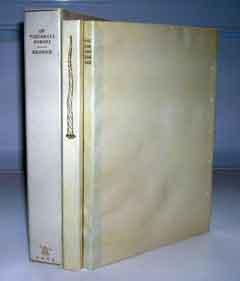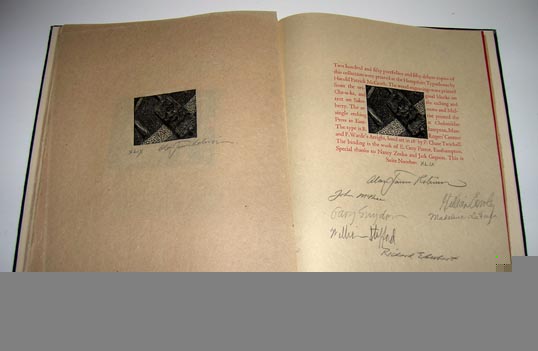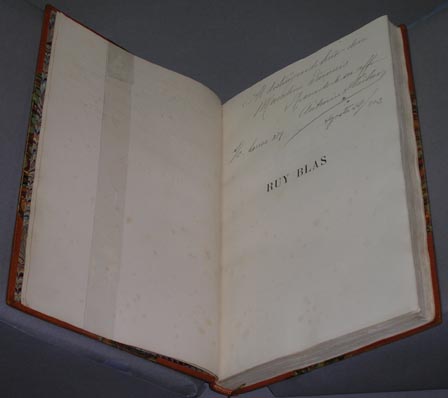
Cheloniidae Press. Browne, Sir Thomas
Pseudodoxia Epidemica: Of Unicornes Hornes. Illustrated by Alan James Robinson. Introduction by Jan van Dorsten
Cheloniidae Press, [NP: but Williamsburg, MA]: 1984
First Edition, Artist Proof issue, one of 5 copies only, all on obsolete Whatman paper (blue-white laid ca. 1962), from a total issue of 225, all signed by the artist, as follows: 5 AP copies (this copy) in an elegant full limp vellum non-adhesive binding, title in gilt on spine, frontispiece etching in 2 states, an extra suite (14), each signed and numbered, and two extra suites of working proofs (28), each signed and labeled "wp," and an original drawing, a unicorn within an oval border signed in full by Alan J. Robinson, housed in 1/4 vellum folder with Narwhal "horn" tooled in gold gilt on spine, housed in tan cloth over boards with vellum spine stamped with title in gold gilt; 15 State Proof copies, bound in full vellum non-adhesive limp binding with an original drawing and an extra suite of prints plus a suite of working proofs of the prints and state proofs of the etching; 60 deluxe copies in vellum binding and an extra suite; 150 regular copies on T.H. Saunders Laid. Page size: 9 1/2 x 7 inches. Bound by Gray Parrot with his binder's ticket at lower rear turn-in: full limp vellum, matching quarter vellum sleeve for extra suites all housed in vellum and linen clamshell box, box slightly worn with 2 or 3 minor bumps, book fine. Illustrated with 15 woodengravings and one etching by Robinson, the text is set and cast in Van Dyck Monotype by Winifred and Michael Bixler and printed by Harold Patrick McGrath in black and blue at Hampshire Typothetae. Jan van Dorsten, Professor of English Literature at the University of Leiden, Nethrlands and Head of the Sir Thomas Browne Institute there, has written an introduction on Browne's life, work and thought especially for this volume, which is Chapter XXIII of PSEUDODOXIA EPIDEMICA . In all, this is a lovely book, full of fantasy and romance, beautifully produced and executed by one of the finest naturalists working today.
More from Priscilla Juvelis Inc.
Snakes Are Not Nice
One of 25copies, each signed and numbered by the artist, Lois Morrison, printed on oriental paper from Staedtler's master carve, hand-lettered onto Nideggen paper, grommeted, and bound in sharkskin over board forming 12-piece "snake" that is highlighted with colored threads glued down on images, several pieces to each piece, with images and text on one side and sharkskin on the reverse, housed in maroon "snake-catching" bag tied with green cord, fine. The pieces were laser cut by Julie Chen. The title is hand lettered and on the sharkskin-side of the snake's head - which also has stamped eyes. Yes, SNAKES ARE NOT NICE but this book is!
Oarsbread Realization
McCallion, Barry Unique artist's book, hand-written and hand-painted by the artist / author, Barry McCallion on cream Rives BFK a Barry McCallion continues his exploration of the narrative of his created world (or is it his observations of this world?) through chance word and particular image. His creation of the Oarsman - a sailor / traveler who rows (backward of course) towards his mythical destination - is intriguing. His voyages may be autobiographical or completely haphazard. He hoists his sails or locks his oars and is off - and we follow, observing from the sidelines, to places we otherwise would not go.
Roadkills. A Collection of Prose and Poetry. Illustrated by Alan James Robinson. Texts by John McPhee, Gillian Connelly, Gary Snyder, Madeline DeFrees, William Stafford and Richard Eberhart
Cheloniidae Press. McPhee, John First Edition, one of 50 Deluxe copies, from a total issue of 300: 50 Deluxe copies bound in quarter leather, with text printed on Sakomoto and the prints on Cha-u-ke plus an extra suite of the prints, signed by the artist and all of the authors; 250 regular copies with text on Mulberry paper, bound in paper, signed by the artist. Page size: 12 inches x 8 3/4 inches. Bound by Gray Parrot: quarter grey morocco with tire tracks blind tooled across spine and title in blind, matching black chemise with blind tooled tire tracks, all housed in grey morocco and black cloth clamshell box. Illustrated with 11 woodengravings (10 roadkills and one tire track/broken muffler as colophon) and one etching, the text was printed in red and black by Harold Patrick McGrath at Hampshire Typothetae in Bruce Rogers' Centaur and Frederick Warde's Arrighi which was hand set in 18 point by P. Chase Twichell. The artist explains in "On the Conception of Roadkills" that he had originally planned a portfolio without text of some of those animals he had encountered during his many drives to and from college. He adds, "Meanwhile, friends began to call my attention to writers who had also been inspired by the casualties of the highways: John McPhee, in Travels in Georgia, and poets Madeline DeFrees, Gillian Connelly, Gary Snyder, William Stafford, and Richard Eberhart. Thus I began to conceive of Roadkills as a book, with images and text interwoven." And what a book it is -- the text in red and black on tan Japanese paper, the black woodengravings on a darker tan paper, red Japanese paper as preliminaries -- all making a powerful statement about "The Dead by the Side of the Road." This is the very rare second book of the press; the deluxe edition with its extra suite and signatures of all the authors has long been out of print. In addition.
The Bells: A Numerical Exploration. Images by Donald Glaister. Text by Edgar Allan Poe
Glaister, Donald. Poe, Edgar Allan Artist's book, one in a series of 10, on paper, polyester film, and metals, by noted book artist, Donald Glaister, who has signed and numbered the book on the colophon. Page size: 14-1/2 x 8-7/8 inches. Bound by the artist: painted paper over boards, hand-sewn with each page on tabs to allow complete opening of each page spread, grey morocco spine, title written in dark grey on aluminum inset on front panel, edges of front and rear panel edged in orange, housed in clamshell box. Designed, painted and bound by the artist, this book uses paper, various metals and polyester. The text is printed by laser on mylar; the mathematical formulas and equations are hand painted on metal inserts in each of the pages / boards. Using Edgar Allan Poe's diacopic masterpiece, THE BELLS (1849), the artist uses this important American text as a basis for visual exploration. The musicality of "The Bells" is reflected in the artist's use of numerical notations / equations. While not musical notations, they do reflect that sensibility - as do the arabesques that link each page spread. The page colors reflect the increasing darkness and frenzy of Poe's text, starting with the bright silver-white opening page spread with bright blue arabesques that run across both recto and verso and the interleaved mylar text page. The silver bells are reflected in the three aluminum inserts on each page - perfectly placed to lead the eye to the smaller text page in the middle. The "golden bells" of the next - not quite gold but more orange-toned - page spread have the mathematical equations written on gold metal, in black, orange, and white and the arabesques running across both pages (in a more frenetic pattern than the preceding page) again highlight the text. The subsequent page spread (alarm bells - fire) is a deeper orange, more frenzied. The iron bell page spread is dark grey - with the painting and inset mathematical formulas drawing the eye in to a very deep, dark place indeed. A masterful book, what one expects from Donald Glaister, who manages to astonish with each new work. Edgar Allan Poe's word mastery and dark visions are perfectly served by the non-representational art, painted on each page, of Donald Glaister.
Ruy Blas, drame en cinq actes. Un portrait et quinze compositions de Adrien Moreau. Grave a l’eau-forte par Champollion
Hugo, Victor One of 350 numbered copies on velin du Marais numbered and paraphed in pen by publisher, L. Conquet.from a total edition of 500. Page size: 10 5/8 x 7 1/8 inches. Bound by Antonio Flaiban: 3/4 tan morocco and marbled boards; spine paneled, gilt decorated, title gilt, top edge gilt (gilt-stamped on front blank: Flaiban Enc.), original covers bound in, matching slipcase, some light foxing throughout. Inscribed by the binder on the half-title, "Al distinguido Senor don Marcelino Dumais / Recuerdo de so affect. / Antonio Flaiban / S. / C. Larrea 389 Sgostgo 28 / 1902." Illustrated with 16 etchings (10 vignettes and 6 full page) by Champollion (1848-1901).Pseudodoxia Epidemica: Of Unicornes Hornes. Illustrated by Alan James Robinson. Introduction by Jan van Dorsten: https://rarebookinsider.com/rare-books/pseudodoxia-epidemica-of-unicornes-hornes-illustrated-by-alan-james-robinson-introduction-by-jan-van-dorsten/